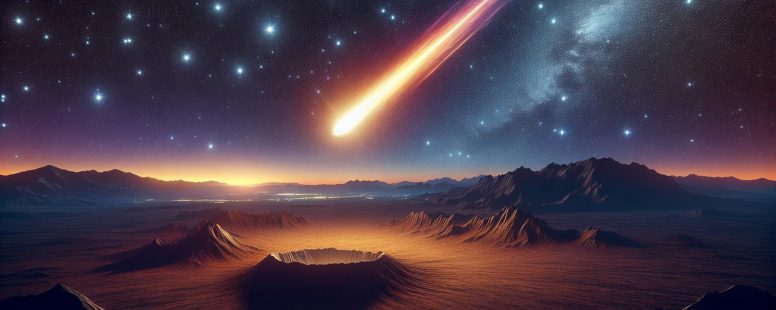Difference Between Meteor and Asteroid: Key Facts and Unique Characteristics Explained
Imagine gazing up at a star-studded sky when a streak of light suddenly cuts across the darkness. Is it a meteor? Or could it be something else entirely, like an asteroid? These celestial wonders have fascinated humanity for centuries, yet their differences often remain shrouded in mystery.
You might think they’re interchangeable, but these space travelers are distinct in origin, behavior, and even impact on our planet. Understanding what sets them apart not only deepens your appreciation of the cosmos but also reveals the incredible stories they carry from the far reaches of our solar system. Ready to uncover the secrets of these cosmic wanderers? Let’s explore.
What Is A Meteor?
A meteor, often called a “shooting star,” is a visible streak of light resulting from a meteoroid entering Earth’s atmosphere. Its vivid glow comes from the heat generated as it speeds through the air.
Definition And Characteristics
A meteor occurs when a meteoroid, a small fragment of rock or metal from asteroids or comets, burns up upon atmospheric entry. The friction with air molecules causes incandescence, creating the fiery trail. Most meteors vaporize before reaching the surface, with only some larger ones leaving remnants called meteorites. Their brightness depends on size, velocity, and composition.
Meteors are typically fast, entering the atmosphere at speeds ranging from 25,000 to 160,000 mph. They can appear at any time, though meteor showers—predictable events—offer higher chances of observation.
Common Examples And Observations
Meteor showers, like the Perseids in August and Geminids in December, are annual events caused by Earth’s orbit intersecting debris left by comets. During these showers, dozens of meteors per hour light up the night sky.
Fireballs and bolides represent more intense meteor phenomena. Fireballs are exceptionally bright meteors, while bolides explode, producing visible fragmentation.
Occasionally, meteors surprise with colors—green, orange, or yellow—resulting from varying chemical compositions, such as sodium or magnesium. Focus the next time you see one; its sudden flash captures a piece of our cosmic neighborhood.
What Is An Asteroid?
An asteroid is a rocky object that orbits the Sun, primarily found within the asteroid belt between Mars and Jupiter. Unlike meteors, asteroids remain in outer space unless fragments break off.
Definition And Characteristics
Asteroids are small, irregularly shaped celestial bodies that range in size from a few feet to over 600 miles across. They lack atmospheres and typically consist of rock, metal, or a combination of both. NASA data estimates there are over 1.1 million known asteroids in our solar system. Most follow stable elliptical orbits, but some, known as near-Earth asteroids, cross Earth’s orbital path. When sunlight reflects off an asteroid’s surface, its brightness can vary due to its irregular shape.
Asteroids differ from planets because they lack sufficient mass to become spherical through self-gravitation. Sometimes, their orbits bring them close enuff to be observed with ground telescopes. Examples like Ceres, once classified as an asteroid, were reclassified as dwarf planets due to size and mass.
Types Of Asteroids
Asteroids fall into three main categories based on composition. C-type (chondrite) asteroids are the most common, comprising clay and silicate rocks. S-type (stony) asteroids are made of silicate minerals and nickel-iron, while M-type asteroids primarily consist of metallic iron and nickel.
Interestingly, location plays a role in these distinctions. For instance, C-type asteroids are usually farther from the Sun, preserving volatile compounds like water. S-types dominate the inner asteroid belt, reflecting differences in solar radiation exposure. The asteroid Vesta, an S-type example, has been extensively studied due to its volcanic surfaces.
Binary asteroids, systems where two asteroids orbit one another, add another layer of complexity. Examining these structures offers insights into gravitational interactions and formation processes in our solar system.
Key Differences Between Meteors And Asteroids
Meteors and asteroids, though often conflated, differ significantly in composition, size, location, and behavior. Understanding these differences underscores their unique roles in the solar system.
Composition And Structure
Meteors derive from meteoroids, which are fragments of rock or metal originating from asteroids or comets. When meteoroids penetrate Earth’s atmosphere, intense friction causes them to burn, displaying a streak of light. Their chemical make-up varies, often containing elements like iron, nickel, or silicates.
Asteroids, but, are larger celestial bodies composed of rock, metal, or carbon-based materials. C-type asteroids are carbonaceous, S-type asteroids are silicate-rich, and M-type asteroids feature higher metallic content. Unlike meteors, they retain their structure in the vacuum of space without combustion.
Size And Appearance
Meteors are brief luminous phenomena, not physical objects per se, but the visible effects of meteoroids vaporizing during atmospheric entry. These light trails vary in intensity, with larger meteoroids producing brighter displays like fireballs or bolides.
Asteroids, in contrast, range significantly in size, from under 33 feet to nearly 600 miles in diameter. Large asteroids like Ceres present spherical forms, while smaller ones often exhibit irregular shapes due to weaker gravity. Their surfaces often show craters, grooves, and varying textures based on composition.
Location And Behavior
Meteors are transient, appearing only within Earth’s atmosphere when meteoroids collide with air molecules. Meteor showers, such as the Leonids, occur as Earth passes through debris fields left by comets, creating predictable and recurring events.
Asteroids occupy stable orbits around the Sun, primarily within the asteroid belt between Mars and Jupiter. Some deviate, becoming near-Earth objects. For instance, asteroid Apophis is monitored due to its close approach predicted for 2029. Binary asteroids interact gravitationally, providing a unique window into solar system dynamics.
How Meteors And Asteroids Impact Earth
Meteors and asteroids influence Earth in different ways, ranging from benign to catastrophic. Their interaction with our planet depends on their size, composition, and velocity.
Potential Risks They Pose
Both meteors and asteroids can present significant threats to Earth under certain conditions. Meteors, often small and swift, generally burn up upon entering Earth’s atmosphere. Larger fragments, but, survive the descent and become meteorites, causing localized damage. For instance, the Chelyabinsk meteor, which measured about 66 feet in diameter, exploded over Russia in 2013. The blast injured over 1,500 people and damaged thousands of buildings, due to shockwaves and broken windows, not the direct impact.
Asteroids pose greater risks because of their larger sizes. An asteroid striking Earth could trigger widespread destruction, create immense craters, and even lead to mass extinction events. The Chicxulub asteroid, about 6 miles wide, is believed to have caused the dinosaur extinction 66 million years ago. Near-Earth asteroids (NEAs), like 99942 Apophis, periodically draw attention due to their potential to come dangerously close to Earth. Such possibilities drive scientific efforts to monitor and mitigate asteroid threats.
Historical Impacts
Earth’s geological record bears evidence of numerous impacts, underscoring the historical significance of meteors and asteroids. Over 190 confirmed impact craters dot the planet, each a testament to the dramatic encounters with these celestial bodies. The Barringer Crater in Arizona, spanning 0.75 miles wide and 560 feet deep, formed approximately 50,000 years ago from a nickel-iron meteorite impact.
Meteor showers also narrate Earth’s ongoing history with space debris. For example, the Leonid meteor storms, recorded for centuries, showcase repeated encounters with the debris of Comet Tempel-Tuttle. Similarly, massive impacts from asteroids, like the Sudbury Basin in Canada, provide insights into Earth’s early solar system environment. These historical records highlight the enduring link between our planet and the ever-changing cosmos.
Conclusion
Understanding the differences between meteors and asteroids opens a window into the dynamic nature of our solar system. These celestial phenomena, though distinct, both offer valuable insights into the origins and evolution of the cosmos.
Whether you’re marveling at a meteor streaking across the night sky or studying the vast asteroid belt, each tells a unique story about the universe. By exploring their characteristics and impacts, you gain a deeper appreciation for the intricate connections between Earth and the space beyond.
- GDP Versus GNP: Understanding the Key Differences - November 14, 2025
- Which Is Best: CV or Resume? Understanding the Differences - November 14, 2025
- Which Is Best: ECE or CSE? - November 14, 2025







